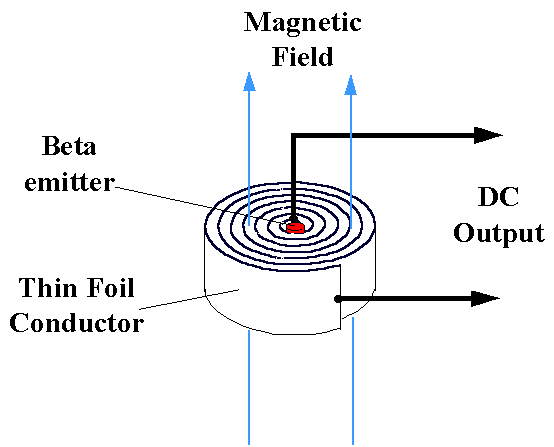
Testatika Generator and Over-unity
By Cyril Smith
JLN Labs - Posted on 4th February 1998
Having read Nelson Camus’ article purporting to "explain" the Testatika over-unity generator (http://members.aol.com/overunity2/nelson/testatic.htm) I am of the opinion that the real explanation is hidden amongst the 19th century electrical mumbo jumbo which makes up much of the machine (Leyden Jars, Horseshoe Magnets, Whimshurst Generator and so on). From the description of spiral wound foil capacitors containing radioactive material and placed within current carrying coils it strikes me that perhaps the real energy comes from Beta particles (fast electrons) absorbed into the electrical circuit.
To extract energy from Beta particles it is not just enough to capture them. Clearly this will result in a current flow according to the capture rate, but current by itself is not power. The kinetic energy of the particle must be captured and this will result in potential difference or voltage. If a Beta particle enters a thin foil conductor normal to its surface and is captured, then the potential difference associated with giving up its kinetic energy can be expected to occur across the opposite faces of the foil. If however the Beta particle were turned so as to enter at a shallow grazing angle to the surface, not only would the probability of capture be increased (since the particle will travel further within the material) but the potential difference will occur along the length of the foil. Beta particles travelling even at relavistic velocities can be turned within short distances by relatively weak magnetic fields, so the concept shown in the following Figure suggests itself.

A radioactive Beta source is at the centre of a spirally wound coil of thin conductive foil, e.g. copper or aluminium (insulation between turns is omitted for clarity). Beta particles travelling radially from this source travel at right angles to a DC magnetic field (e.g. from a permanent magnet), hence follow circular paths, they spiral outwards. When their trajectories align with the foil curvature their probability of capture increases. Voltage impulses from each capture arrive at the output terminals all at the same polarity.
This is such an obvious scheme for getting electrical power from a radioactive source that it is difficult to believe that it has not been investigated before. Has anyone tried it? Perhaps with just a single turn of foil. Does it have to be in vacuum?
Cyril Smith
Return to the Quantum Electrodynamics page